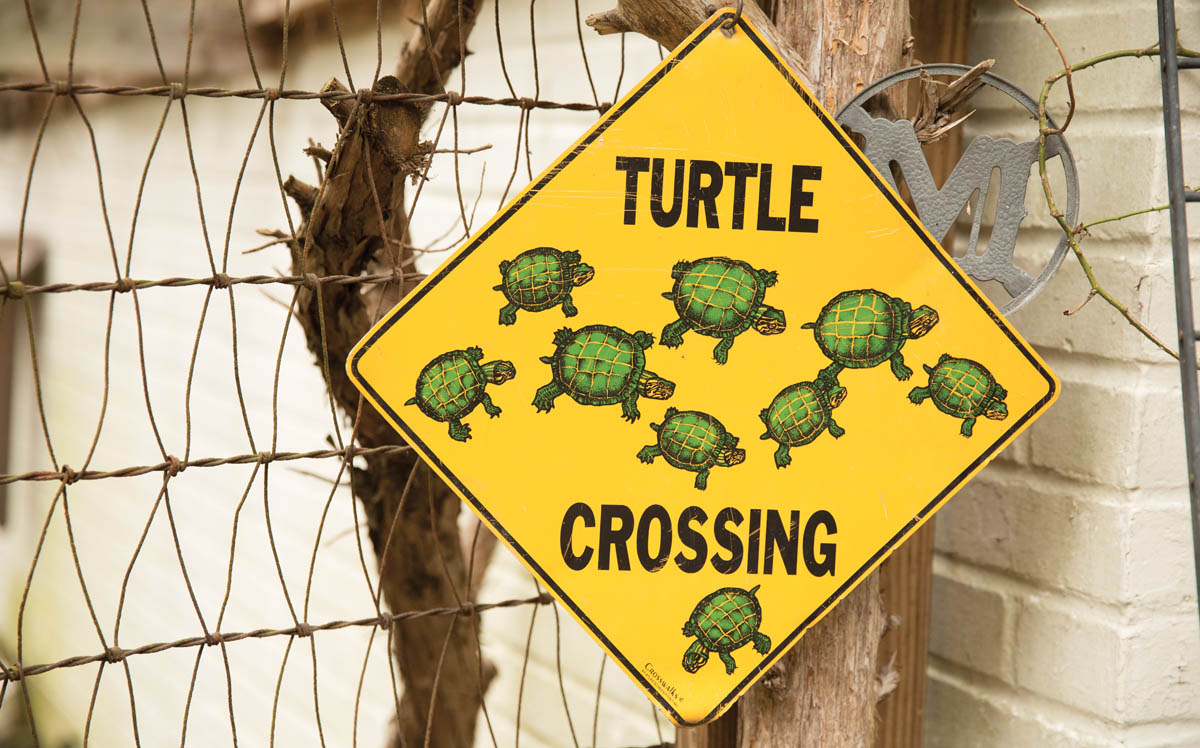
Signs, flowers, sculptures, murals, and tchotchkes from any or all nations are suitable accessories for a custom coop.
When I was a young man I worked at an egg farm. For one day. The environment was all bleakness interrupted by concrete. Not fit for man nor beast. Our Hentopia looks nothing like that egg farm. While maybe our chickens don't recognize the many little touches we add to their domain, we and our guests sure do. I think the hens do appreciate having a tree to perch in and crickets to chase. So we keep adding little improvements for them and us. We're always happy to have one more reason to cruise some junk shops.

Signs, flowers, sculptures, murals, and tchotchkes from any or all nations are suitable accessories for a custom coop.
Zookeepers often point out the “enrichment” features enlivening each animal’s enclosure at the zoo, such as ropes for monkeys to climb or indestructible balls for pandas and bears. The idea is to let the animals entertain themselves while they wait for dinner (which can never come soon enough).
Chickens like to have a little fun, too. For birds that don’t get to spend every waking moment free-ranging, it helps their general happiness and productivity when we provide a few enrichment features in their pens.
To me, part of the fun of any new adventure comes from acquiring the proper accessories: items that enrich the experience for us as well as for our chickens. That might be functional things like funky feeders or fancy gates, as well as fun items bought at junk shops or boutiques, like vintage signs, antique drawer pulls, Tibetan prayer flags, or farm animal sculptures — whatever strikes your fancy. Here are some tips on creating a playful hen habitat.
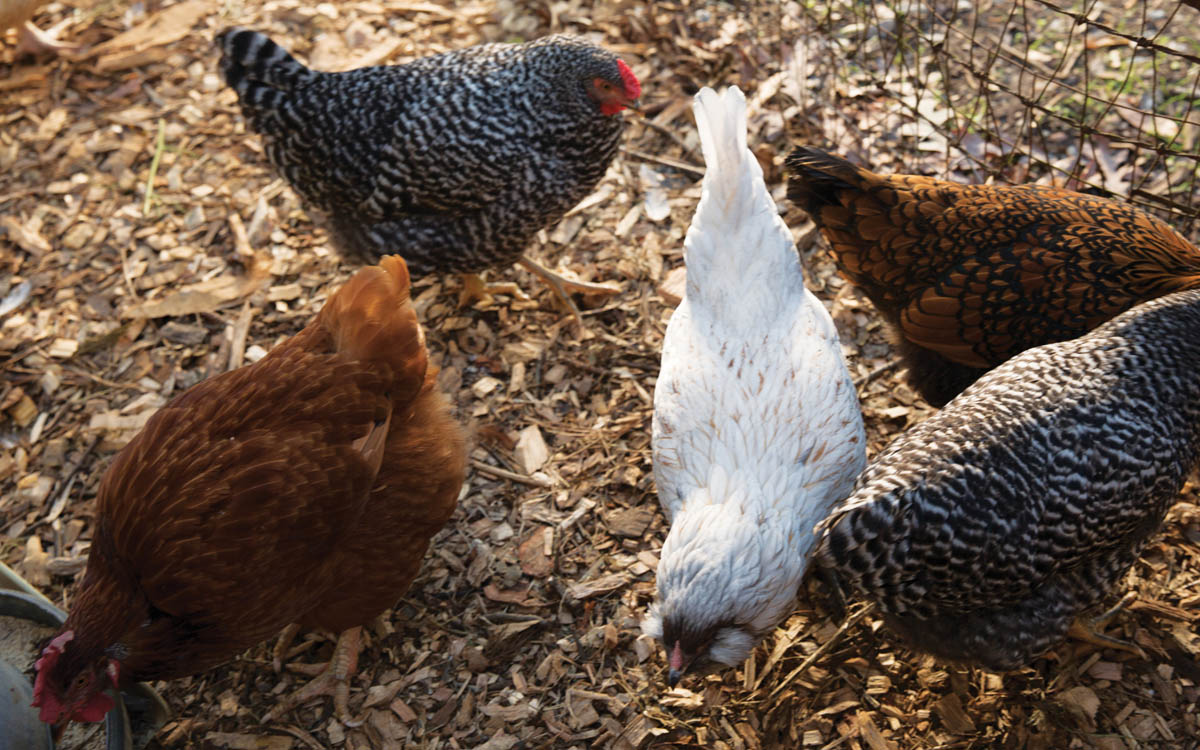
Chickens like to scratch the ground looking for bugs and seeds to eat. It’s what they do instead of heading into the office or catching up on social media, and it’s called foraging. Most of our yard is off-limits for foraging, as chickens can destroy a lawn or flower bed quicker than you can mistakenly hit “reply all” on a snarky office e-mail.
Scratching and searching for treats in the wood chip snack bar is one of the high points of their day.
Most of the time our hens forage in the pen, but since the pen is a small space we enrich it a couple of times a year with free wood chips dumped in our driveway (on request!) by local tree trimmers. Adding a 4- to 8" layer of wood chips to the pen provides a food source for soil insects that happily sacrifice themselves for our chickens’ welfare. (At least I think the bugs are happy. The chickens certainly are. Every bug they eat is that much less feed I have to buy, which makes me happy, too.) The decomposing wood chips also provide an environment for microbes that quickly decompose the chicken poop in the pen.
We also throw leftover garden seeds into the mulch, and our girls come running. Scratching and searching for treats in the wood chip snack bar is one of the high points of their day. As the hens scratch, the seeds get mixed up in the mulch, which creates a more challenging process for the hens and makes it last longer than tossing seeds onto bare dirt.
Henkeepers realize another benefit from the wood chips: the pen isn’t muddy when we need to top up a feeder or do any other chores. Some readers may be thinking, “Our pen is never muddy. We have a roof over it.” A roofed pen is not uncommon, and in areas with long snow seasons it may be necessary. Chickens don’t enjoy the snow and, depending on the depth, rarely scratch their way down to the soil.
The downside to a roofed pen is that the ground underneath will be dry as a desert, too dry for the poop to decompose, and unfit for any bugs that want to sacrifice themselves as a crunchy afternoon snack. The chickens will still scratch the dry soil, but they’ll be as disappointed as prospectors at a played-out gold mine. Even in snowy regions, it may be worthwhile to leave part of the pen with just fence wire as a roof, so that rain can wet the ground during the rest of the year.
Yet another benefit henkeepers can realize from enriching the pen with wood chips is compost. After four years, the ground level of our pen had risen about 8 inches with a rich layer of composted chicken poop and wood chips. I shoveled that layer into a wheelbarrow and spread it on our vegetable garden. It took me only a couple of hours, and I could hear the garden’s sighs of delight and whispered promises of future bumper crops.

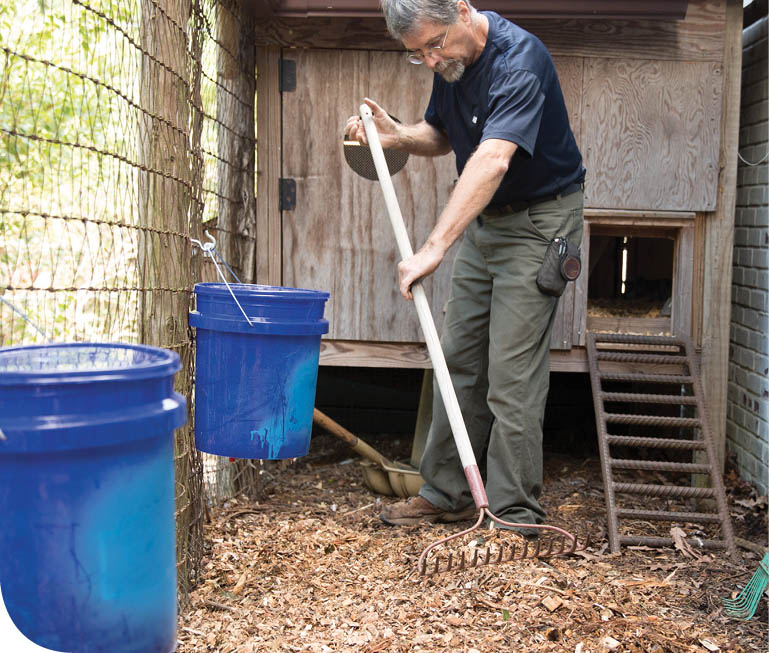
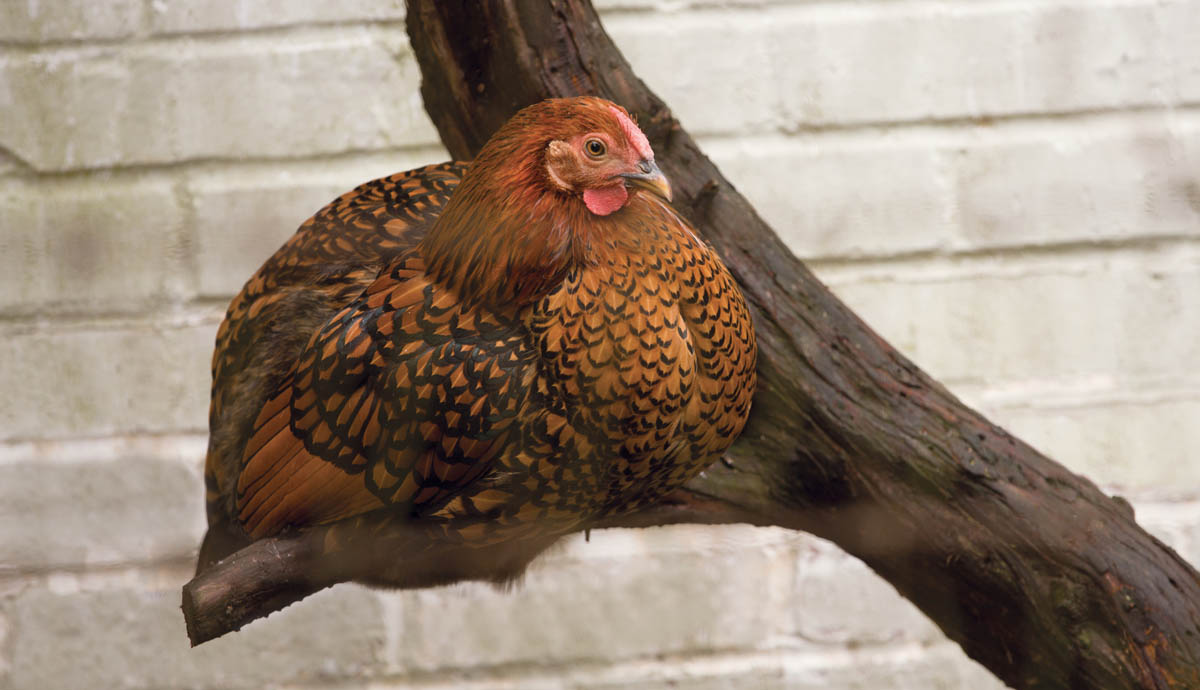
Stella d’Oro watches the world from the tree trunk.
As any henkeeper quickly learns, even an upside-down pie pan will entice a chicken to hop onto it to get a better view of her surroundings or to assert her dominance in the hen hierarchy. They do it because they’re channeling their ancestral instincts.
Chickens evolved as forest birds in Southeast Asia. Sometimes during the day, they’d hop up into the lower branches of trees to scout for dangers, or just to feel like they were the lords of all they surveyed. Later on, after a good dinner of crunchy bugs, rich seeds, and succulent greens, they’d hop back up into a tree to roost the night away, safe from predators.
To support that daytime behavior, I installed the twisting trunk of a dead juniper tree at a quirky angle. I clipped away the smaller twigs and left the sturdy skeleton of the trunk and some side branches thick enough to support a well-fed bird. I anchored the bottom of the trunk in the soil and lodged the top against a rafter that ran across the roof of the pen.
Three of the branches show erosion of the bark that indicates regular use. We enjoy seeing Buttercup or Poppy up high, taking a good look around, or hunkered down for a rest. Being juniper, the trunk is rot-resistant, but any species of tree will last a few years and give your girls those long views they seek.
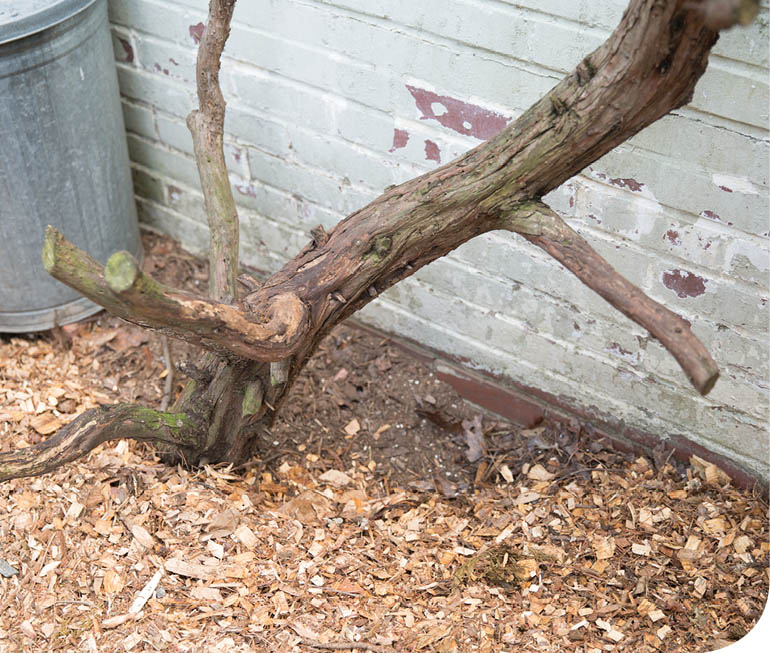
Years ago I remember one of our local chicken gurus, Bob Davis, saying that he had started clamping garden greens inside the pen fence to make it easier for his girls to eat. I didn’t think much of it at the time, but I remembered his comments when I saw a large office binder clip on Chris’s desk.
Certainly, chickens can eat small items, like pieces of grain, off the ground. But larger things like cabbage leaves or bunches of carrot greens can be trickier. Chickens evolved tugging leaves off rooted plants; if the leaves don’t fight back, chickens will have a harder time breaking off a piece small enough to eat. They will probably never figure out that standing on the leaves will make it easier to tug away with success. Whenever I simply tossed greens on the ground I got used to seeing lots of them going uneaten.
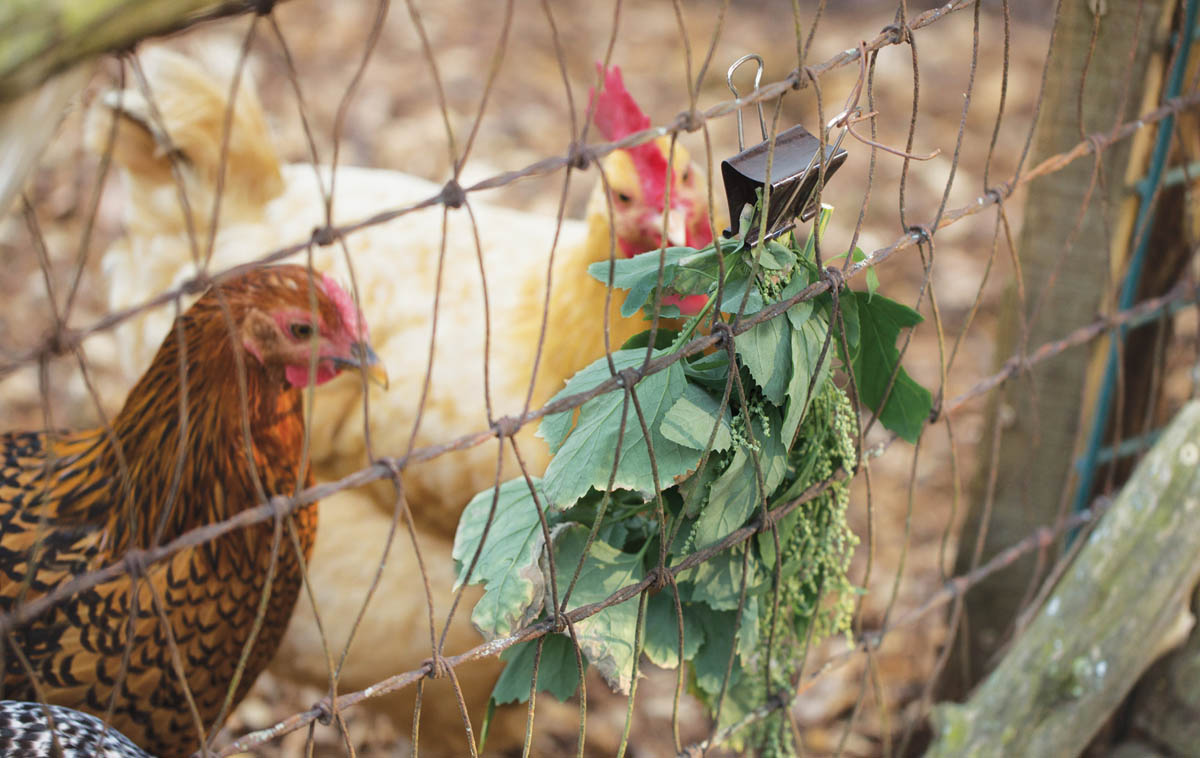
A clump of pigweed in the binder clip creates a feeding frenzy.
Chickens evolved tugging leaves off rooted plants.
Then I saw the big office binder clip on Chris’s desk, and I quickly envisioned a contraption like Bob’s. I scooped up the binder clip and scouted the garage for a 6" length of tie wire (twine, zip ties, or anything similar will do). I loaded the clip with a bunch of overmature kale and tied the clip’s handle to the fencing of the gate at head-height for a chicken.
I positioned the binder so that we could crouch down, open the gate, and with one hand outside the gate pinch the binder open. With the other hand inside the gate, we could slip that day’s leafy memo into the mouth of the binder clip — all while keeping the girls from making a great escape, of course.
With the gate closed, I watched the tasty tug-of-war begin. Our hens really went to work, going after the beetles on the kale (the garden’s organic). As soon as they had hoovered up the beetles, they quickly ripped the kale down to its skeletal stalks.
You’re welcome, girls.
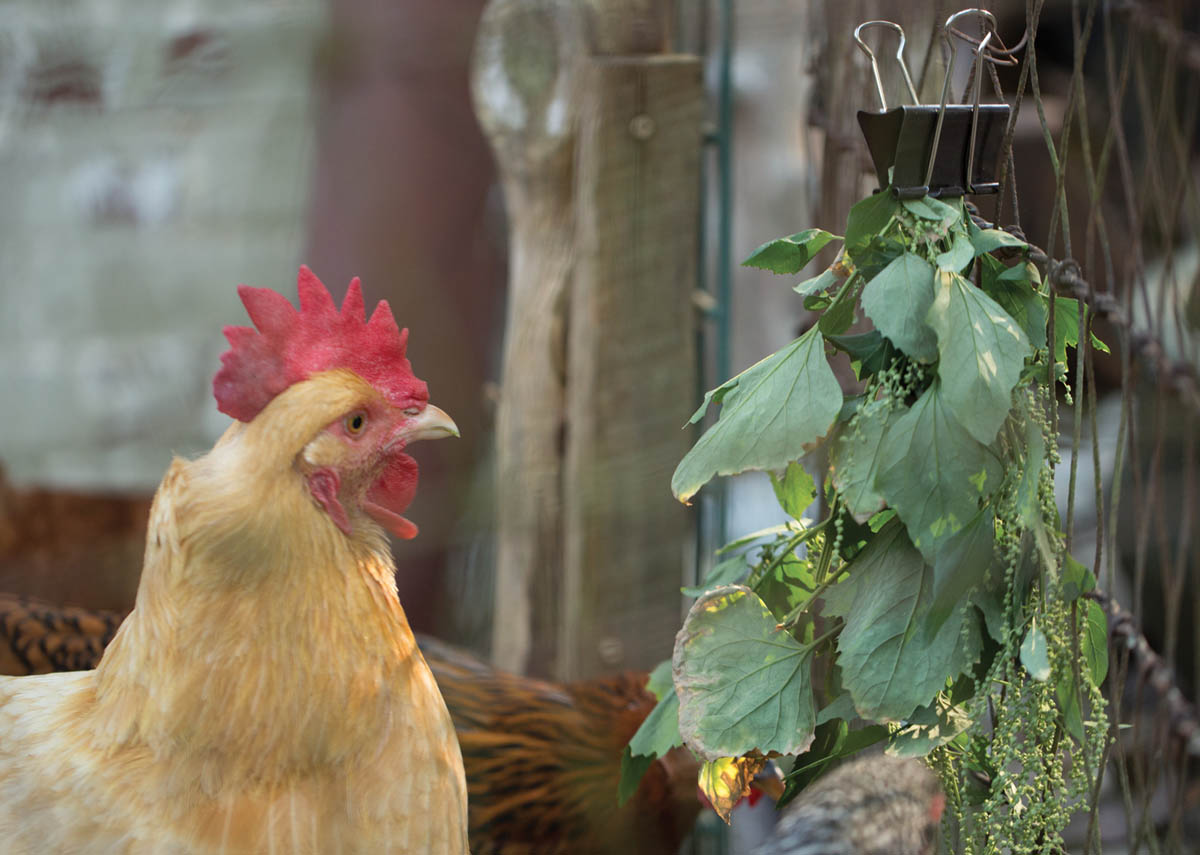
Buttercup studies the presentation of today’s hors-d’oeuvres.
The coop and the hen pen are two enclosures necessary for proper chicken-keeping. In addition, I highly recommend acquiring a third one: a dandy device known as a dog crate. This accessory falls into the category of functional rather than fun: you’ll want it for isolating one or more birds.
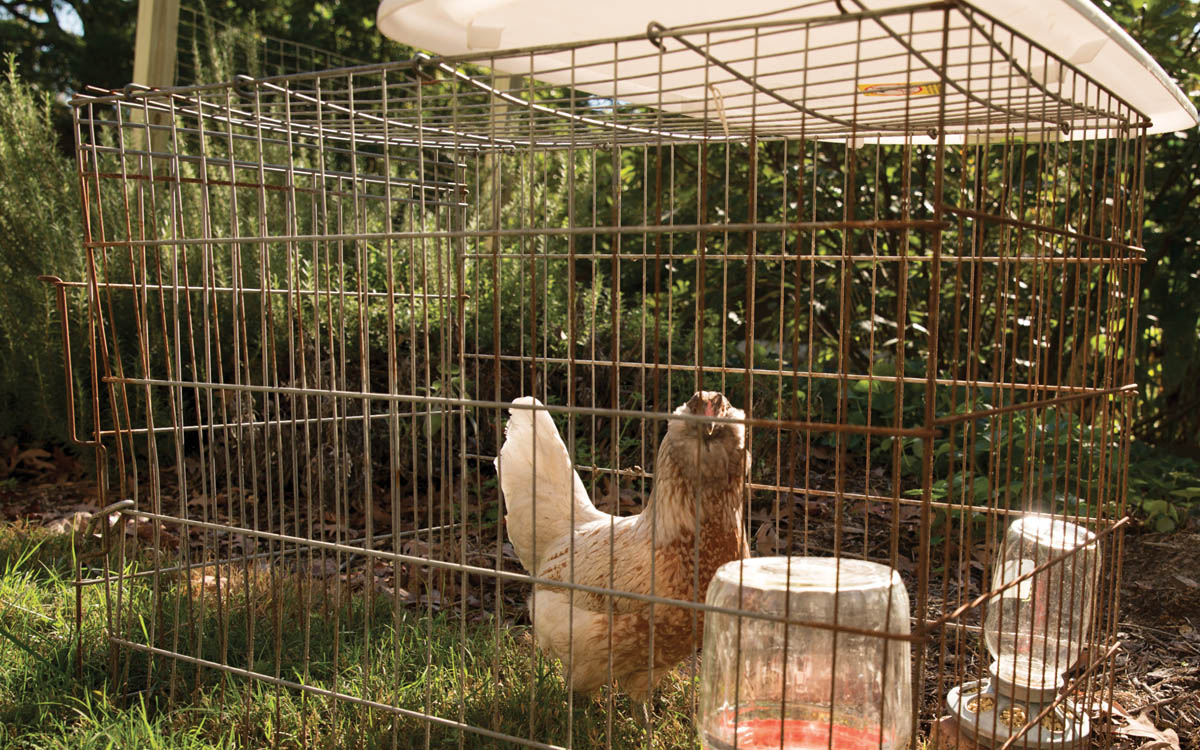
Violetta sojourns in a dog crate to break her from a broody spell. The lid from a plastic tote gives her midday shade.
There are at least four occasions when a henkeeper will have need of an isolation chamber:
Many years ago, when I saw a discarded yet functional metal dog crate by the side of the road, I suspected it would come in handy for something at some point. Into the back of the garage it went. A year later we adopted a mature Black Marans hen and named her Dahlia. We needed her to get acquainted with the old girls without being pecked like a piñata. Bring out the dog crate.
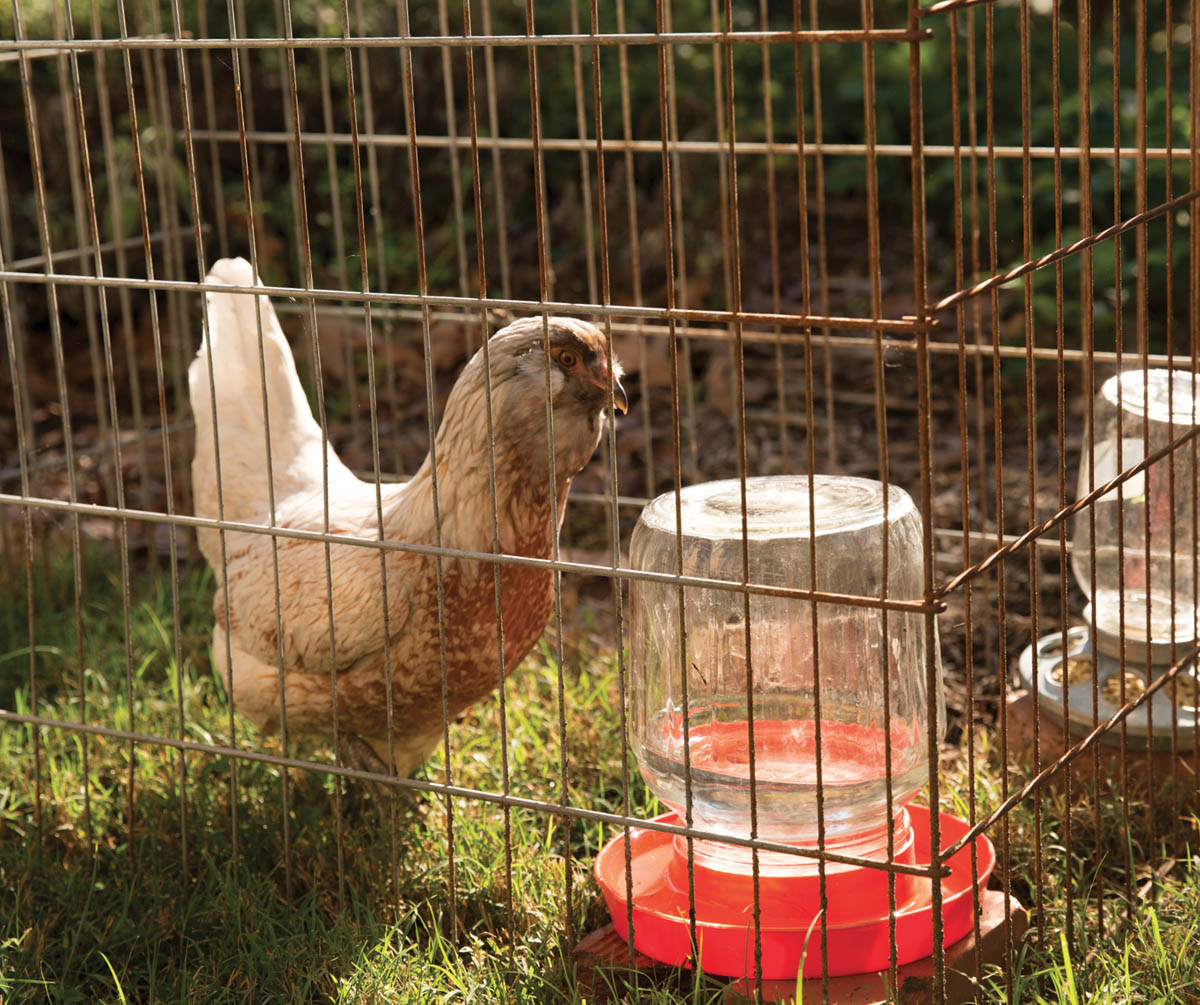
A new or salvaged dog crate is a safe way to isolate birds. Be sure to provide a waterer and feeder as well as cover from sun and rain.
The crate was big enough to hold a Labrador retriever, so it had plenty of room for a single hen. The heavy-duty wire cage had a door in one end and a hinged top panel too (cleverly designed to lie flat for storage.)
We wanted our new hen to be able to live in the crate for a week or two, until our original birds got used to her. We put the crate inside the pen with a couple of bricks at one end to support a store-bought waterer and feeder at chest height for Dahlia. That put them high enough that any scratched debris wouldn’t clutter them up. A tarp over the top kept out rain and direct sun.
It did feel a bit like punishment to sequester a hen in a dog crate even though Dahlia had room to move around and still be within sight and smell of her new flock. She also had plenty of shelter, food, and water.
The original birds, Buttercup and Poppy, weren’t happy about the newcomer, but they couldn’t get at her. After about 10 days, they stopped paying attention to Dahlia and we let her out to join the flock with no bloodshed. Mission accomplished.
We still have the crate. Between active uses, it functions as a bin that holds the waterer, feeder, roof tarp, and other paraphernalia, including a salvaged cat carrier that we used to transport Dahlia in the car.
A year later, Dahlia got broody in the nest box — she mistakenly thought she could hatch some eggs. With no roosters, the eggs are infertile and therefore won’t hatch; and if the eggs don’t hatch, a broody hen never gets the message to leave the nest. Under those conditions she could suffer or even die from dehydration or starvation. A henkeeper must break this mood to save the hen.
We were ready. We popped Dahlia into the dog crate for her own good. After a week, we let her out, but she went right back to brooding in the nest box. We hadn’t waited long enough. Another trip to the dog crate for another week did the trick.
As our old girls have aged and drop fewer eggs, we’ve raised four new chicks to adulthood: Domenica, Mezza Luna, Stella d’Oro, and Violetta. When they were chicks, the dog crate gave them a safe sanctuary in which to be near our older hens until they were recognized as part of the flock.
Dahlia had room to move around and still be within sight and smell of her new flock.
It’s been decades since I’ve done any fishing, but I still keep a cricket bucket rolling around behind the seat of my pickup truck. The fish have nothing to fear from me when I buy a few dollars’ worth of crickets at the bait shop, but I know the chickens will be very excited. They enjoy any worms or grasshoppers we toss their way, but they sure love them crickets.
A cricket bucket has a solid plastic bottom, but the sides are made of screen to allow the crickets to breathe. The cleverly designed top has a flange that lets you reach a hand in to catch a cricket, but that keeps the crickets from being able to climb out. I picked it up for fifty cents at a yard sale. I probably could have asked to buy it for a quarter, but the sellers looked to be having a slow Saturday.
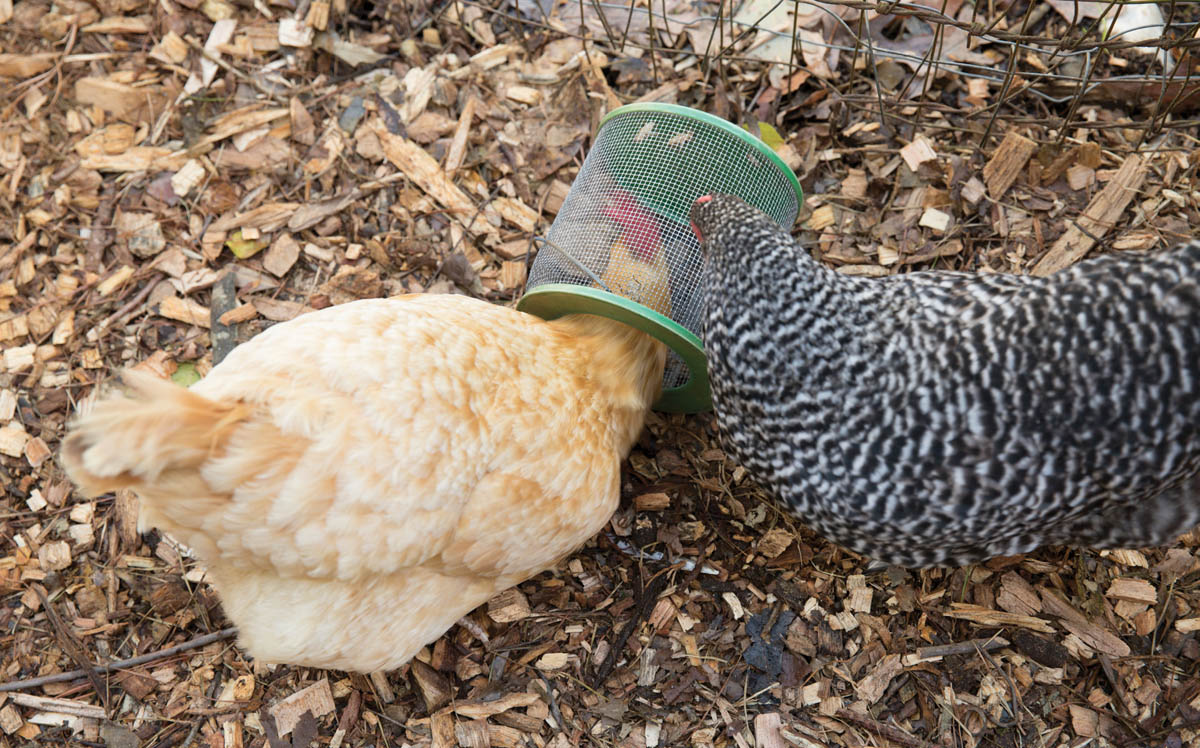
As the top hen, Buttercup gets first crack at the cricket crack while Mezza Luna waits her turn. Rest assured, chickens are not vegetarians (or egalitarians or pacifists either).
I reach into the bucket and toss a dozen crickets into the pen to get the chickens running around. They’re stretching their necks and snagging crickets off the ground and off each other’s backs. It’s like watching cowboys catching calves at a rodeo. Then I put the cricket bucket down on its side and let the girls at it. Being unable to get at them through the screen confuses the hens at first, but they eventually see how this game works. Buttercup is dominant, so she has the first go, but the others get their licks in, poking their heads into the bucket and coming out with juicy, crunchy prizes.
Of course, if you don’t live near any bait shops, you can still buy crickets at any pet store that supplies them for feeding pet lizards. Chickens did evolve from dinosaurs, which is Latin for “terrible lizards.” Therefore the crickets are fair game for a quick-and-dirty lizard rodeo.

A fishing accessory like this cricket bucket makes a good corral for the cricket rodeo.
Henkeepers I’ve Known
When Hans Voerman was a child in Holland in the 1970s, stories about deforestation and dying coral reefs made him angry and sad. He had fantasies about protecting wild lands from destruction. As a young man, though, he couldn’t find opportunities in that line of work.
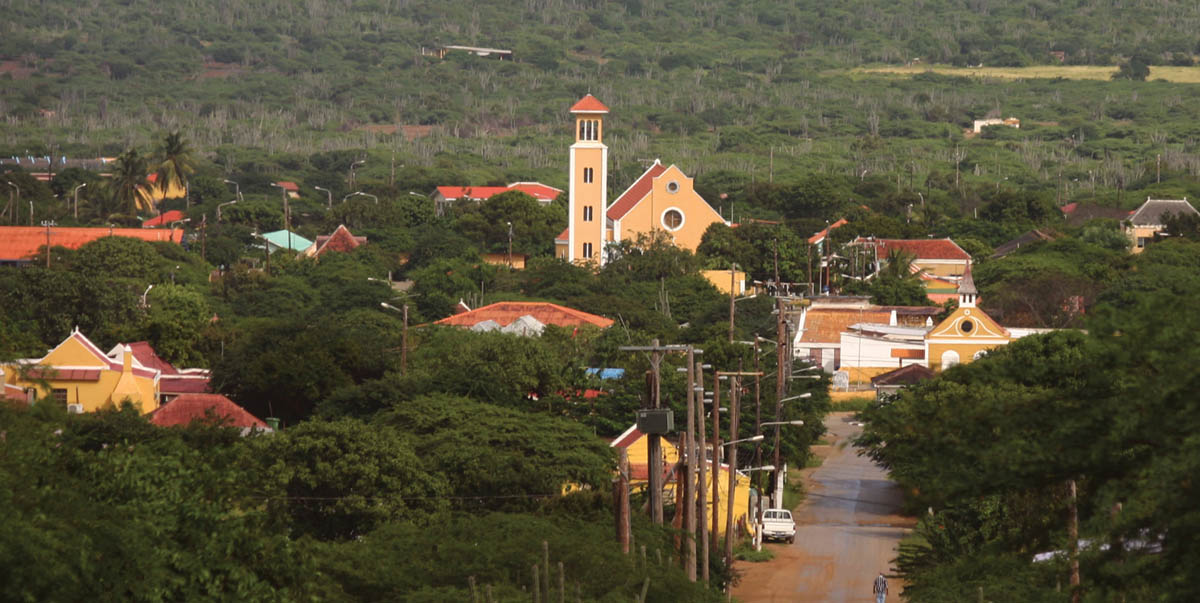
The small town of Rincon on the tropical island of Bonaire
Hans served as a maritime survival instructor in the Dutch Navy and as a civilian as second mate on a tramp freighter, helping with docking and navigation while the ship hauled salt, timber, tobacco, pumpkins, onions, used cars, and once an entire factory to ports around the globe. In his travels he saw ruined lands as well as lush areas, and the experience reinforced his desire to find a piece of ground that he could preserve, care for, and make his living from.
Today he protects a 1.5-acre property in the backcountry of the Caribbean island of Bonaire. He plants native trees that support Amazonian parrots, Caribbean parakeets, orioles, emerald hummingbirds, bats, and other hardy wildlife on his desert island. To be self-sufficient, he also runs a small eco-lodge, leads outdoor tours, and keeps ducks, pigs, and chickens.
Hans discovered Bonaire in the early ’90s on a visit to his former scuba team officer. They had served together in the Dutch military, where Hans learned to handle underwater explosives. The weeklong visit turned into a month, and a month turned into a life choice as Hans settled on Bonaire.
Like many Caribbean islands, Bonaire suffers from the overgrazing caused by free-ranging goats and feral donkeys, and its growing popularity has led to development pressure that concerns local environmentalists. “Every day we lose trees on this island,” Hans says. He stays active in environmental debates and educates locals and tourists at his lodge and on his tours.
Before coming to Bonaire, Hans had no experience with animals: “None, absolutely zero. But I always liked to be self-sufficient. It’s relaxing to watch and take care of animals. And to occasionally eat them.” About 10 years ago a friend gave him some chicks to start a flock. He keeps a rooster and often has 20 to 25 birds of all ages, of a hardy local breed that everyone just calls a Bonairean chicken.
The screen and lath are strong enough to keep out the main intruder: omnivorous, cat-sized, blue-tailed lizards.
The rooster has some of the coloration of a Dutch Bantam, but without a doubt other breeds are mixed in. Dutch Bantams are from Indonesia, a former Dutch colony. It’s said they are as close as you can get to the look of the original red jungle fowl, but Hans’s birds are bigger than bantams and lay a normal-sized egg. They probably have an interesting heritage, given that the Spanish, the Dutch, and the U.S. Army (during World War II) have all governed the island.
Hans doesn’t worry about critters like raccoons, foxes, or possums, because there aren’t any carnivorous, four-legged mammals on Bonaire . . . except for stray dogs. When he bought the land, he installed waist-high wire fencing on the property line. That keeps out the dogs, along with the goats and donkeys. With the grazing animals at bay, Hans’s land resembles a lush, square oasis in a nibbled-down desert of small trees, candle cactus, agaves, and scruffy grass.
For extra protection Hans built a cinder block coop for the birds to roost in and get out of the occasional rains. One side of the coop opens into a pen lined with window screen and wooden lath. The screen and lath are strong enough to keep out the main intruders: omnivorous, cat-sized, blue-tailed lizards that would eat the kitchen scraps, grain, and perhaps the eggs.
These aren’t the only threats to chickens. Another island farmer lost all his birds a few years ago when he tried to eliminate a wild honey bee colony in a storage locker. The riled-up bees, probably Africanized, attacked, stung, and killed all the chickens. The farmer retreated to his car to nurse just a few stings, but has a new flock now and no wild bees on the grounds.
In Bonaire’s dry weather with a nearly year-round high of about 81°F (27°C), the chickens rarely have disease or pest problems.
In Bonaire’s dry weather with a nearly year-round high of about 81°F (27°C), the chickens rarely have disease or pest problems. Infrequently, Hans says, one bird will seem a little strange — slow or quiet — and then will die the next day. So they don’t burden him with vet bills.
Since the island is only 12 degrees north of the equator, day length doesn’t change enough to affect egg production. The birds are hardy, but for Hans, they aren’t high producers. He reports getting “two to three” eggs a day from his flock, “sometimes more, sometimes nothing. If you have eggs for a while you have to save them up, as sometimes they don’t produce anything.”
He periodically slaughters an older bird for meat. Because they are older and tough, he cooks them in a pressure cooker with half a kiwifruit, which helps tenderize the meat. These birds mostly go into a soup, or he dices the meat into fine cubes to go with rice or pasta.
Occasionally his guests at the eco-lodge take an interest in the flock and help with the feeding and watering. A former girlfriend had a deathly fear of chickens. Because she was the one who fed them whenever he was away from the lodge, Hans set up a special device so she wouldn’t have to enter the pen. He poked a 6-inch-diameter, 8-foot-long PVC pipe at a jaunty 45-degree angle through the wall of the chicken pen, creating, in effect, a dumbwaiter or laundry chute for these classy birds. His girlfriend could toss the feed and kitchen scraps into the pipe, and they would slide down to land on the dirt floor of the pen. A tight-fitting lid on the end of the pipe kept rain and critters out, and she could feed the chickens without having to enter the pen or even go near them.
After decades of relying on off-island production, Bonaire is seeing agriculture slowly return. Some back-to-the-landers are growing sorghum in the dry climate, for example, but there aren’t enough island-grown grains for Hans’s chickens. He could buy layer feed from Venezuela or the Dominican Republic. To feed his animals grain that’s free of antibiotics, however, he buys feed imported from Holland at $19 for a 55-pound bag, supplementing it with kitchen scraps.
On his land, he allows a small tree called French cotton (Calotropis procera) to grow, and after a rain he harvests the leaves to feed the animals. Not a true cotton plant, it’s a milkweed from Africa with a silky fluff, and a favorite of the monarch butterfly.
Hans built the lodge, where he lives and keeps his animals, with his own hands. It has a stone foundation, rustic ceiling beams, and a breezy second-floor porch with a dining area, a hammock, and a hanging chair.
The eco-lodge uses solar panels for electricity, a windmill to pump well water, and roof-mounted barrels to heat the water and create water pressure for the kitchen and the indoor and outdoor showers. The roof also supports a stargazing platform, from which you can also see owls, bats, and nocturnal birds called nightjars. This distant from distracting urban lights, one can also see meteors, the Milky Way, and the constellation Auriga, the chariot driver.
Hans chose Auriga as the name of his eco-lodge because his last name, Voerman, also means chariot driver. When not tending his lodge or his animals, Hans drives a modern chariot in the form of a black, four-wheel-drive, four-door pickup truck with a bright red bat painted on the fender.
When Hans bought his land a dozen years ago, it was a barren, goat-eaten bit of scrub. By pursuing his dream of protecting nature, Hans, like the Dutch boy with his finger in the dike, is helping to hold back the flood of development. And he’s making a cozy home for himself, his guests, and his chickens at the same time.
For more information on Hans, his eco-lodge, and his tour business, see the References and Resources section.
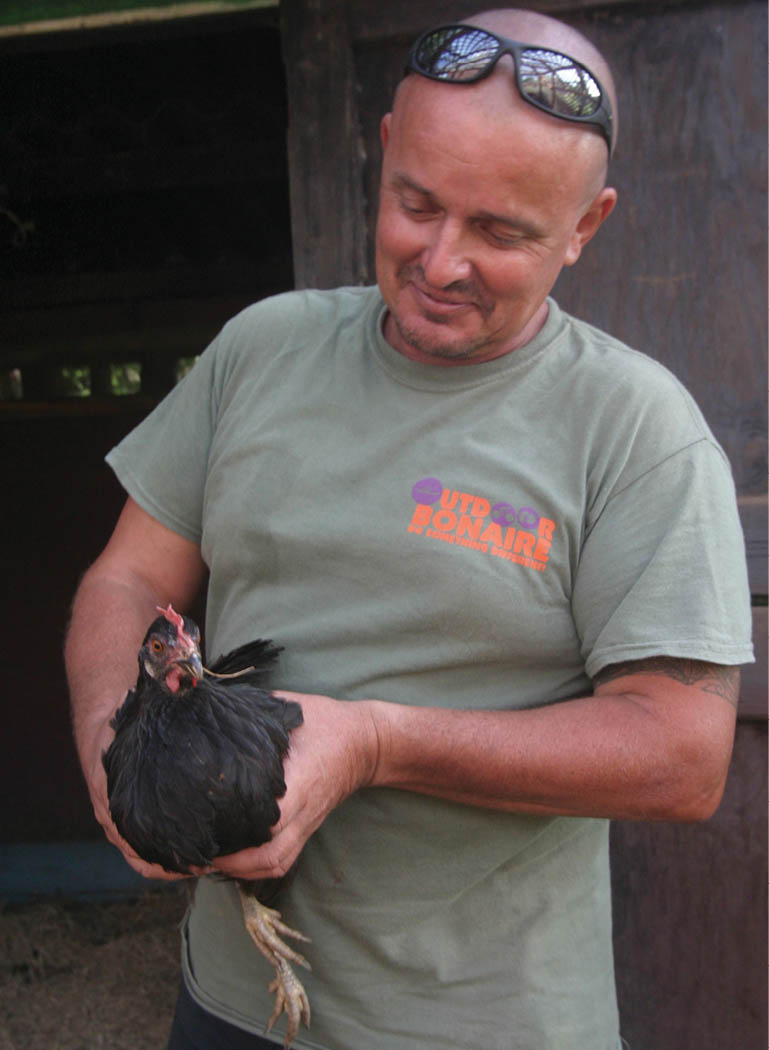
Between caving tours, Hans Voerman inspects one of his Bonairean chickens.